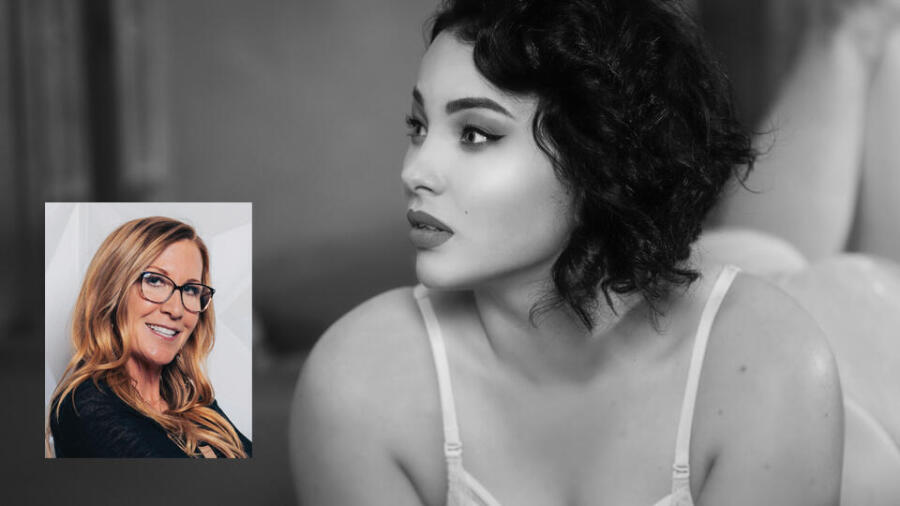According to reports, 68 percent of female shoppers are a size 14 or above. Yet despite beautiful models such as Ashley Graham breaking through, mid-size models and plus-size models still don’t have much visibility in fashion.
Because of the disparity between mainstream fashion world images and actual women who buy the clothes, brands are still largely ignoring plus-size and mid-size bodies, despite body positivity campaigns.
Plus-size consumers agree that there still needs to be even more representation and more relatability in the fashion industry, in every sector, including lingerie.
Brands Aren’t Using Mid-Size or True Plus-Size Models
I received a catalog last week from a very well known women’s apparel brand. I won’t throw them under the bus, but they sell the bohemian lifestyle, complete with every drapey silhouette you could imagine. The catalog actually belonged to my friend, who is a passionate fan of the brand. While she isn’t plus size, she represents the mid-size women’s market.
She is also terribly disappointed every single time she orders a garment from their website. Why? Because the models used to showcase the clothes are wearing size 2 and my friend is a size 12. To be clear, a size 2 dress on a little frame with no boobs does not translate the same as a size 12 dress on a curvy frame with 36DD boobs. Fashion brands are doing better than they have in previous years, but mid sizes — and especially plus sizes — are terribly underrepresented.
No, I’m not saying every fashion brand should be offering all sizes for everyone. As a part of the apparel industry, I understand it isn’t always practical to do so. Sizing, grading and quality associated with production costs can make it challenging. However, for fashion and lingerie brands that do offer large through 3X sizes to not represent those sizes in their advertising is a big failure.
Models Ashley Graham and Robin Lawley have gained popularity in recent years. These models are both a size 10, making them midsize. I think we all breathed a huge sigh of relief when these models started hitting the runway. We thought, “Finally, women that show what clothes will look like on me!”
But instead of bringing light and visibility to mid-size women, the industry and media treat them as plus-size models, despite their objections. As many plus-size women will testify, mid-size is not plus.
While mid-size has helped spark the conversation, mid and plus sizes still got lumped into one “curvy” category. This only showed how focused the fashion world is on super-slim models, by labeling anyone else that doesn’t fit that mold as simply “curvy.”
Plus-size models and influencers such as Kat Stroud, Tess Holliday and Lauren Nicole have paved the way for a lot of plus-size women to feel represented in the fashion world. Nevertheless, plus-size consumers agree that there still needs to be even more representation and more relatability in the fashion industry, in every sector, including lingerie.
“As a plus-size woman, I can assure you that we are buying lingerie. And part of the problem has been that we are in no way represented in the scheme of things. It’s hard to find an actual image of a person of size representing or modeling for these brands — and when you consider that 80 percent of the population is over a size 12, well, that seems not only irresponsible, but talk about missing out on those dollars,” says plus-size model and author Kat Stroud.
Clothes Aren’t Being Designed to Fit Plus-Size Bodies
Falling in love with a garment online, only to have to return it when it arrives, can leave a woman feeling pretty self-conscious. Sending back a garment you had high hopes for not only makes a person feel bad about the way they look, but it can also create brand distrust.
For a lot of women, the struggle with body positivity is real. When fashion brands or even plus-size influencers misrepresent a size audience, they are committing brand loyalty suicide.
It’s possible that mid-size and plus-size women are being ignored because it simply takes more time and money to manufacture garments that fit different bodies. The typical designer will create a sample pattern fit for a size 2 or 4, and that sample can then be used for multiple sizes.
However, using those samples for sizes upwards of 10 and 12 will sometimes distort the fit. The designers would need to invest in new patterns and resources to optimally create the same garments for different sizes. Many designers choose not to make the extra effort.
This explains why in-betweeners in the size 14 category feel they are too large for industry-standard size 14s, but are too small for plus-size 14s. The clothes are made with completely different sample patterns. And for women in the 18-and-up sizes, there isn’t much to choose from — like, at all.
Shopping can be especially challenging for women looking for plus-size lingerie. In the media, most plus-size women are not depicted as sexual beings. Often, they’re portrayed as uncomfortable or serve as comedic relief. But in real life, plus-size women can be as sexual and as comfortable with themselves as anyone. This disparity is hurting women and the fashion industry.
"Women of all shapes and sizes are sexual beings. Feeling and looking sexy is not something that is reserved only for specific body types, and representation matters,” says Ruby Roxx, a plus-size model and influencer. “When women (or humans in general) see someone who looks like them, in lingerie or any form of media, we are reminded that we are normal humans, worthy and deserving of having those feelings and experiences too. We feel connected and inspired to live our lives unapologetically, and we look and feel incredible doing it. All body types, sizes, shapes, genders, races, backgrounds, and abilities are worthy of representation and feeling sexy, powerful and included."
I imagine the frustration plus-size women must be feeling as they flip through magazines, website catalogs, or get served ads featuring women who aren’t even their sizes trying to sell them a garment. Even brands that claim to be plus-size and use plus-size models are still missing the mark. Many plus-size brands carry sizes ranging from 14/16 through 28 and 40, yet never use a size 28 or 40 model in their catalogs or social media creatives.
Supporting Body-Positive Brands Supports Body Positivity
Plus-size women who feel unseen by retailers have a godsend in the form of influencers such as Lizzo, Meaghan O'Connor, Madeline Jones and Tabria Majors. Fashion influencers who share their style picks on social media help women feel represented, something many retailers are failing at.
“We want to see bodies like ours being represented because that’s reality; we’re here and not going anywhere. And moving forward it’s important to showcase that diversity because those are the people spending the money and buying the products,” says Kat Stroud.
As long as women keep shopping at retailers that don’t cater to them, the industry isn’t going to change. If women want to see more plus-size fashion, they should support stores and outlets that acknowledge them as valuable customers.
Samantha DeMartini is the founder and president of Kix’ies.









